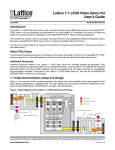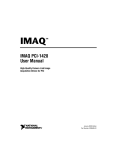Download CLV-403 User`s Manual
Transcript
C LV- 4 0 3 C A M E R A L I N K V I D E O S P L I T T E R User’s Manual Document # 200595, Rev 1.0, 5/6/2009 Vivid Engineering 418 Boston Turnpike #104 • Shrewsbury, MA 01545 Phone 508.842.0165 • Fax 508.842.8930 www.vividengineering.com • [email protected] Table of Contents 1. Introduction 1 1.1. Overview 1 1.2. Features 3 1.3. Functional Description 4 1.4. Typical Applications 6 1.4.1. Standard Base Application 6 1.5. Specifications 7 2. Interface 8 2.1. Front Panel Connections 8 2.2. Rear Panel Connections 9 2.3. Camera Connector Signals 10 2.3.1. Cable Shield Grounding 10 3. Mechanical 12 3.1. Dimensions 12 3.2. External Power Supply 13 4. Regulatory Compliance 14 4.1. FCC Compliance Statement 14 4.2. Canadian Compliance Statement 14 5. Revision History 15 1. Introduction 1.1. Overview Designed for multi-camera systems, the CLV-403 Camera Link1 Video Splitter interfaces two Camera Link cameras to two frame grabbers each using standard Camera Link cables. This enables the use of secondary frame grabbers for applications requiring parallel or distributed processing, monitoring, etc. One frame grabber acts as master and provides control and communications to the camera. The second frame grabber receives camera video data only. The CLV-403 incorporates high-speed 85 MHz interfaces and supports Camera Link base configuration cameras. The CLV-403 also acts as a repeater, doubling the maximum distance between the cameras and the frame grabbers. Housed in a sturdy, compact aluminum enclosure, the CLV-403 Camera Link Video Splitter is well suited for industrial environments. The Camera LinkTM interface standard enables the interoperability of cameras and frame grabbers, regardless of vendor. The Automated Imaging Association (AIA) sponsors the Camera LinkTM program including the oversight Camera Link Committee, the self-certification program, and the product registry. The Camera LinkTM specification may be downloaded from the AIA website, found at www.machinevisiononline.org 1 Camera LinkTM is a trademark of the Automated Imaging Association 1 Camera Link Video Splitter Vivid Engineering CLV-403 A A B CAMERAS B MASTER FRAME GRABBERS 2 1.2. Features • Two independent splitters in a single unit for multi-camera systems • Supports secondary frame grabbers for parallel processing, monitoring, etc • Uses standard Camera Link cables (not included) • Supports Camera Link Base configuration • High-speed 85 MHz interface chipset • Also acts as a repeater, doubling max distance between the cameras and the frame grabbers • Sturdy, compact aluminum enclosure w/ mounting flange • Universal power supply included • 3-year warrantee 3 1.3. Functional Description A block diagram of the CLV-403 Camera Link Video Splitter is provided in Figure 1-1. The CLV-403 features two independent base-configuration splitters in a single unit for multi-camera systems. Each splitter interfaces one camera to two frame grabbers using standard Camera Link cables. One frame grabber is the master (primary), and one frame grabber is slave (secondary). The interface between the camera and the master frame grabber contains the entire Camera Link signal set defined in the Camera Link Specification for “base” configurations. This consists of video data, camera control, and serial communications. The master frame grabber receives video data from the camera, and can also control and communicate with the camera. The interface between the camera and the slave frame grabber contains only the video data signals. The slave frame grabber receives video data, but cannot control or communicate with the camera. Since the CLV-403 regenerates all signals, it also acts as a repeater and supports an additional 10 meters of separation between the cameras and the frame grabbers. The CLV-403 is powered by an external wall plug-in power supply. 4 Serial Comm Link Video Data Camera Control LVDS Rcvr LVDS Xmtr LVDS Xmtr LVDS Rcvr Serial Comm Link Video Data Channel Link Transmitter Video Data LVDS Receiver Camera Control LVDS Rcvr LVDS Xmtr LVDS Xmtr LVDS Rcvr Serial Comm Link LVDS Transmitter Channel Link Receiver Video Data Channel Link Transmitter Video Data CLV-403 Camera Link Video Splitter Figure 1-1: CLV-403 Block Diagram 5 To Camera Link Frame Grabber "B" (Slave) Channel Link Transmitter To Camera Link Frame Grabber "B" (Master) Serial Comm Link Channel Link Transmitter To Camera Link Frame Grabber "A" (Slave) To Camera Link Camera "B" LVDS Receiver Channel Link Receiver Camera Control Video Data LVDS Transmitter To Camera Link Frame Grabber "A" (Master) To Camera Link Camera "A" Camera Control 1.4. Typical Applications 1.4.1. Standard Base Application A typical CLV-403 base application is shown in Figure 1-2. Two independent Camera Link base configuration cameras are connected to a single CLV-403 via standard Camera Link cables. Additional Camera Link cables are then used to connect the CLV-403 to master and a slave frame grabbers for each camera. The master frame grabbers provide camera control and communications, and may also perform processing functions. The slave frame grabbers cannot control or communicate with the cameras, but may be used for parallel processing, secondary processing, camera setup, monitoring, etc. A CLV-403 Camera Link Video Splitter B Slave Camera Link Frame Grabbers A Camera Link Video Splitter Vivid Engineering CLV-403 A A B CAMERAS B MASTER FRAME GRABBERS A B B Camera Link Cameras Standard Camera Link Cables Master Camera Link Frame Grabbers Figure 1-2: CLV-403 Standard Application (Base) 6 1.5. Specifications Table 1-1: CLV-403 Specifications Feature Specification Video Interfaces Camera Link “base” configuration Video Connectors 26-pin MDR type Camera Frequency 20-85 MHz Chipset National Semi. DS90CR287 / DS90CR288A Power Supply Universal wall style w/ US & Europe outlet plugs Power Jack 2.1 x 5.5 mm, center-positive Power Requirements 5-7 VDC, 330 mA (typical) Cabinet Dimensions 5.28” (L) x 2.08” (H) 5.12” (D) Weight 18 oz Operating Temperature Range 0 to 50° C Storage Temperature Range -25 to 75° C Relative Humidity 0 to 90%, non-condensing Compliance FCC Class A, ROHS, (CE EN55024 pending) 7 2. Interface 2.1. Front Panel Connections The CLV-403 Camera Link Video Splitter front panel is shown in Figure 2-1. The front panel contains four video connectors for connecting to the cameras and to the master frame grabbers. The front panel also includes a power indicator. The video connectors are 3M MDR-26 types as specified in the Camera Link Spec. Figure 2-2 identifies the MDR-26 pin positions. Camera Link Video Splitter Vivid Engineering CLV-403 A A B CAMERAS B MASTER FRAME GRABBERS Figure 2-1: CLV-403 Front Panel pin 13 pin 1 pin 26 pin 14 Figure 2-2: MDR-26 Connector Pin Positions 8 2.2. Rear Panel Connections The CLV-403 Camera Link Video Splitter rear panel is shown in Figure 2-3. The rear panel contains four 26-pin MDR video connectors for connecting to the slave frame grabbers, and a DC power jack. The MDR-26 connector is a 3M device as specified in the Camera Link Spec. DC power jack accepts 5-7 volts DC. Polarity is center-positive. A B SLAVE FRAME GRABBERS Figure 2-3: CLV-403 Rear Panel 9 5-7 VDC 2.3. Camera Connector Signals The MDR-26 video connector signal assignments comply with the Camera Link “base” configuration. The camera connector signal assignments correspond to the frame grabber interface defined in the Camera Link Specification. Conversely, the frame grabber connector assignments are as defined for the camera interface in the Camera Link Specification. This arrangement provides compatibility with standard Camera Link cables. Table 2-2 identifies the signal assignments for the MDR-26 video connectors. 2.3.1. Cable Shield Grounding Camera and frame grabber cable “outer” shields are connected to the CLV-403 aluminum case. The case is isolated from the CLV-403 circuitry and the cable “inner” shields. The frame grabber cable “inner” shield connects to circuit digital ground, maintaining signal reference levels between the CLV-403 and the frame grabber. 10 Table 2-2: MDR-26 Connector Assignments Camera Link Signal Name Camera Connector Pin # (frame grabber pinout) Frame Grabber Connectors Pin # (camera pinout) Signal Direction Inner shield 1 1 N/A Inner shield 14 14 N/A X0- 25 2 CAM → FG X0+ 12 15 CAM → FG X1- 24 3 CAM → FG X1+ 11 16 CAM → FG X2- 23 4 CAM → FG X2+ 10 17 CAM → FG Xclk- 22 5 CAM → FG Xclk+ 9 18 CAM → FG X3- 21 6 CAM → FG X3+ 8 19 CAM → FG SerTC+ 20 7 FG → CAM SerTC- 7 20 FG → CAM SerTFG- 19 8 CAM → FG SerTFG+ 6 21 CAM → FG CC1- 18 9 FG → CAM CC1+ 5 22 FG → CAM CC2+ 17 10 FG → CAM CC2- 4 23 FG → CAM CC3- 16 11 FG → CAM CC3+ 3 24 FG → CAM CC4+ 15 12 FG → CAM CC4- 2 25 FG → CAM Inner shield 13 13 N/A Inner shield 26 26 N/A “FG” = Frame Grabber, “CAM” = Camera 11 3. Mechanical 3.1. Dimensions The CLV-403 Camera Link Video splitter cabinet dimensions are shown in Figure 3-1. The CLV-403 is housed in a sturdy aluminum enclosure. The body is extruded aluminum, with detachable front and rear endplates. The enclosure incorporates a mounting flange. The flange contains four predrilled holes (0.15” diameter) for convenient equipment mounting. A mounting drawing is provided in Figure 3-2. Camera Link Video Splitter A B CAMERAS B MASTER FRAME GRABBERS m ou nt in g fla A ng es ) CLV-403 5. 12 "( in cl ud in g 2.08" Vivid Engineering 5.28" Figure 3-1: CLV-403 Cabinet Dimensions 12 Mounting Holes (4): 0.15" dia 4.62" 5.12" (Rear) (Front ) 4.76" 5.28" Figure 3-2: Mounting Template 3.2. External Power Supply The CLV-403 is powered by 5-7 VDC and incorporates a standard 2.1 x 5.5 mm DC power jack. Power plug polarity is center-positive. The multi-nation wall-mount power supply (included) handles a wide power range (90264 VAC, 47-63 Hz) and comes with a set of outlet plugs suitable for most countries (US, Europe, UK, etc). The CLV-403 is protected by an internal resettable fuse. 13 4. Regulatory Compliance 4.1. FCC Compliance Statement This equipment has been tested and found to comply with the limits for a Class A digital device, pursuant to Part 15 of the FCC Rules. These limits are designed to provide a reasonable protection against harmful interference when the equipment is operated in a commercial environment. Operation of this equipment in a residential area is likely to cause harmful interference in which case the user will be required to correct the interference at his/her own expense. Changes or modifications not expressly approved by the party responsible for compliance could void the user’s authority to operate the equipment. 4.2. Canadian Compliance Statement This digital apparatus does not exceed the Class A limits for radio noise emissions from digital apparatus set out in the Radio Interference Regulations of the Canadian Department of Communications. 14 5. Revision History Table 5-1: CLV-403 User’s Manual Revision History Document ID # Date 200595-1.0 5/6/09 Changes Initial release of manual 15






































